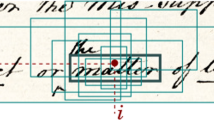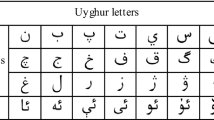Abstract
A computational model for the recognition of multifont machine-printed word images of highly variable quality is given. The model integrates three word-recognition algorithms, each of which utilizes a different form of shape and context information. The approaches are character-recognition-based, segmentation-based, and word-shape-analysis based. The model overcomes limitations of previous solutions that focus on isolated characters. In an experiment using a lexicon of 33,850 words and a test set of 1,671 highly variable word images, the algorithm achieved a correct rate of 89% at the top choice and 95% in the top ten choices.
Similar content being viewed by others
References
Agresti A (1990) Categorical data analysis. Wiley
Aho AV, Kernighan BW, Weinberger PJ (1980) Awk—a pattern scanning and processing language (2nd ed). In: Unix User’s Manual, Supplementary Documents, Regents of the University of California
Baird HS, Graf HP, Jackel LD, Hubbard WE (1989) A VLSI architecture for binary image classification. In: Simon JC (ed) From pixels to features. North-Holland, pp 275–286
Black D (1963) The theory of committees and elections, second edition. Cambridge University Press, London
Bledsoe WW, Browning I (1959) Pattern recognition and reading by machine. Proceedings of the Eastern Joint Computer Conference 16:225–232
Casey RG, Nagy G (1982) Recursive segmentation and classification of composite character patterns. Proceedings of the 6th ICPR, Munich, pp 1023–1026
Duda RO, Hart PE (1973) Pattern classification and scene analysis. Addison-Wesley, New York
Elliman DG, Lancaster IT (1990) A review of segmentation and contextual analysis techniques for text recognition. Pattern Recognition 23(3/4):337–346
Ho TK, Hull JJ, Srihari SN (1990a) Combination of structural classifiers. Pre-Proceedings of the IAPR Syntactic and Structural Pattern Recognition Workshop, New Jersey, June 13–15, pp 123–136
Ho TK, Hull JJ, Srihari SN (1990b) A word shape analysis approach to recognition of degraded word images. Proceedings of the Fourth USPS Advanced Technology Conference, pp 217–231
Ho TK (1992) A theory of multiple classifier systems and its application to visual word recognition. Doctoral Dissertation, SUNY at Buffalo, Department of Computer Science
Hull JJ, Srihari SN (1982) Experiments in text recognition with binary n-gram and Viterbi algorithms. IEEE Transactions on Pattern Analysis and Machine Intelligence, PAMI-4(5):520–530
Hull JJ (1987) Hypothesis testing in a computational theory of visual word recognition. Proceedings of the Sixth National Conference on Artificial Intelligence (AAAI), Seattle, Washington, pp 718–722
Hull JJ (1988) A computational theory of visual word recognition. Doctoral Dissertation, SUNY at Buffalo, Department of Computer Science
Mantas J (1986) An overview of character recognition methodologies. Pattern Recognition 19(6):425–430
McClelland JL, Rumelhart DE (1981) An interactive activation model of context effects in letter perception: Part 1. An account of the basic findings. Psychological Review 88(5):375–407
Mori S, Yamamoto K, Yasuda M (1984) Research on machine recognition of handprinted characters. IEEE Transactions on Pattern Analysis and Machine Intelligence, PAMI-6(4):386–405
Riseman EM, Ehrich RW (1974) A contextual postprocessing system for error correction using binary n-grams. IEEE Transactions on Computers, C-23(5):480–493
Rosenbaum WS, Hilliard JJ (1975) Multifont OCR post-processing system. IBM Journal of Research and Development 19:398–421
Rumelhart DE, McClelland JL (1982) An interactive activation model of context effects in letter perception: part 2. The contextual enhancement effect and some tests and extensions of the model. Psychological Review 89(1):60–94
Schuermann J (1978) A multifont word recognition system for postal address reading. IEEE Transactions on Computers, C-27(8):721–732
Shinghal R, Toussaint GT (1979) Experiments in text recognition with the modified Viterbi algorithm. IEEE Transactions on Pattern Analysis and Machine Intelligence, PAMI-1(2):184–193
Tsuji Y, Asai K (1984) Character image segmentation. SPIE Proceedings on Applications of Digital Image Processing VII, 405:2–9
Wagner RA, Fischer MJ (1974) The string to string correction problem. Journal of ACM 21(1):168–173
Author information
Authors and Affiliations
Rights and permissions
About this article
Cite this article
Ho, T.K., Hull, J.J. & Srihari, S.N. A computational model for recognition of multifont word images. Machine Vis. Apps. 5, 157–168 (1992). https://doi.org/10.1007/BF02626995
Issue Date:
DOI: https://doi.org/10.1007/BF02626995




